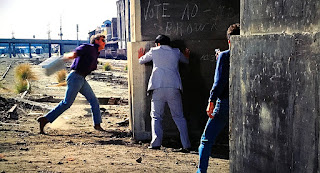Anime is a beautiful art form.
This writer has had a long and complicated relationship with anime. I'm often drawn to its beauty but I'm also often perplexed or kept at arm's length emotionally from the substance of its creators.
Every so often a real gem comes along that keeps my attention. Attack On Titan (2013-present), Knights Of Sidonia (2014-2015) and Star Blazers: Space Battleship Yamato 2199 (2013-2014), the Neon Genesis Evangelion franchise too, are a few fine examples whereby I will often return to each respective project.
The Netflix release for the impressive manga series Blame! (2017) failed to deliver for me and others have also failed to really capture my heart or imagination.
Undeniably many of these feature films and series are filled with imagination, but don't always make a heart and mind connection for me. Short Peace (2013), an anthology assembled by Sunrise studio and by Katsuhiro Otomo and based on his own manga from 1979, is a stunning work of beautiful animation and is likely worth any anime aficionado's time, but is by no means essential.
While the anthology series is making a comeback in some arenas, these are passable stories more notable for their visuals and moving pictures and for many that may be enough.
Director Katsuhiro Otomo drew me to the project. He directs the story Combustible.
My favorites may be the fantastic Gambo by Hiroaki Ando and the science fiction heavy A Farewell To Weapons by Hajime Katoki. Katoki has an almost John Byrne-like quality and his works have included franchises Gundam and Patlabor.
Shuhei Morita's Possessions rounds out the anthology and is an equally stunning bit of animation. Morita directed the OVA Freedom (2006-2008) and worked on Gatchaman Crowds (2013).
Otomo's works loom largest of course having brought to the world Akira (1988; based on his own extensive 1982 manga) and Steamboy (2004). His anthology participation and direction has included Robot Carnival (1987), Neo Tokyo (1987), and Memories (1995). Short Peace is his fourth foray into the anthology concept. Otomo even contributed to the 7-part OVA Freedom for Morita. He was the scriptwriter for Roujin Z (1991) and Rintaro's acclaimed Metropolis (2001).
Short Peace is short on narrative substance and long on visuals. If checking out for an escape to some lush, gorgeously crafted, animated moving pictures is your thing, Short Peace is an essential viewing experience. It won't quite deliver on narrative strength embodied by such films as the wonderful Ninja Scroll (1993) or the classic Ghost In The Shell (1995), but it is absorbing visually.
For those less inclined to embrace the genre and or less narrative-centric storytelling Short Peace may be one to skip. But this writer can tell you the visuals here are sumptuously breathtaking. Despite my own personal reservations and taste, anime fans with an affection for any of the above affiliations should rejoice.
Grade: A (for anime fans)
































































